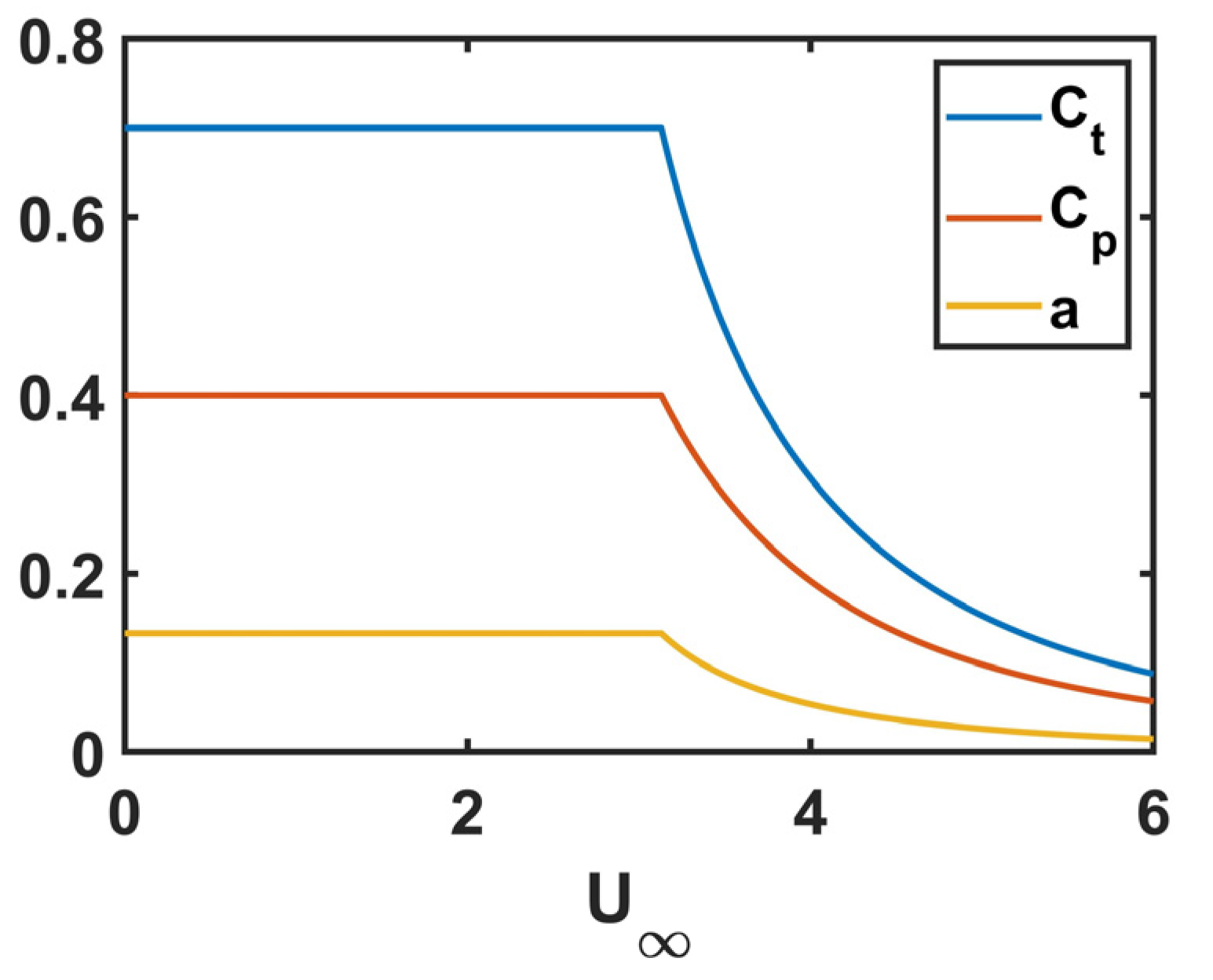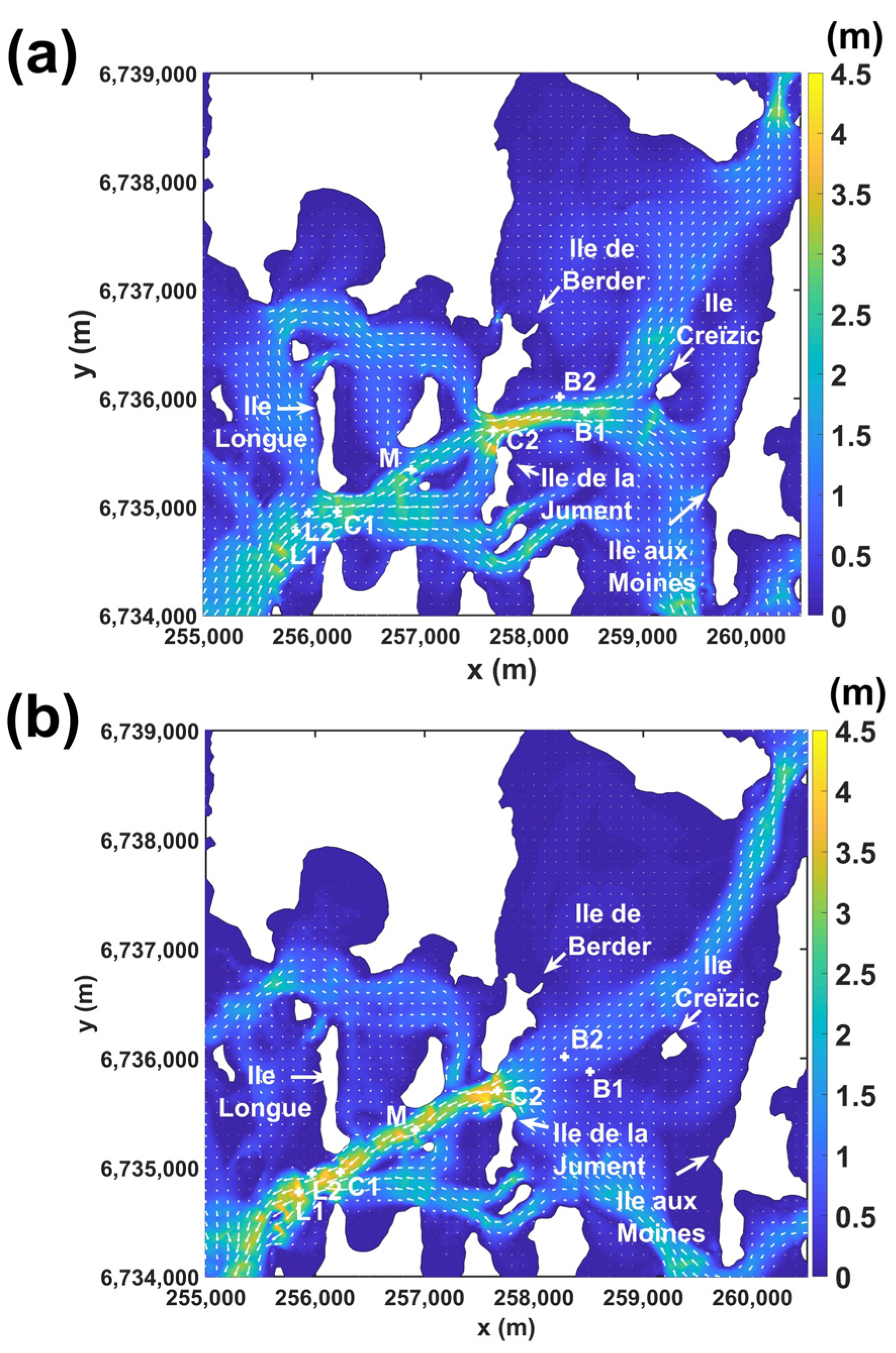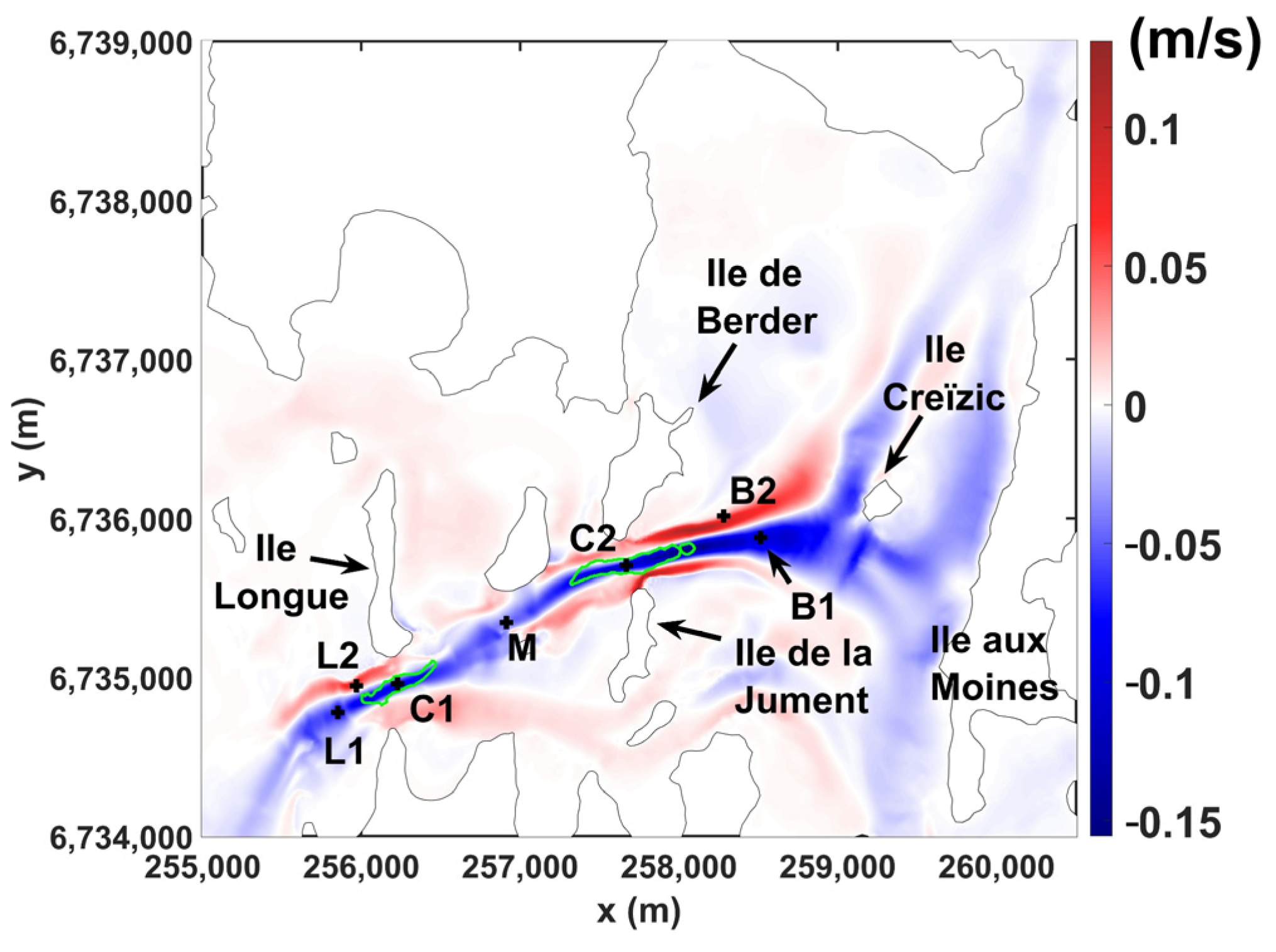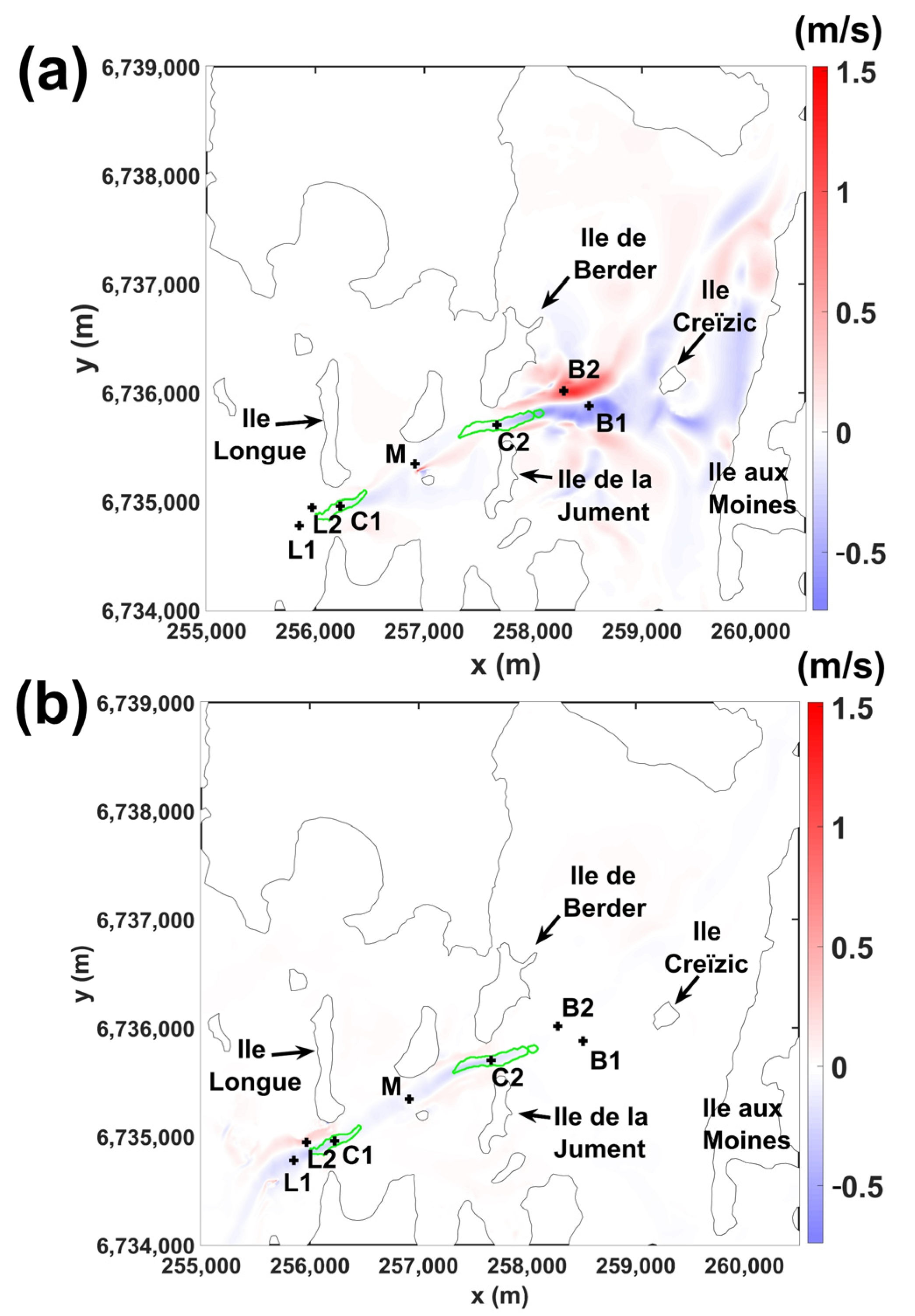The Potential of Tidal Energy Production in a Narrow Channel: The Gulf of Morbihan
Abstract
:1. Introduction
2. Materials and Methods
2.1. Site Description
2.2. Field Data
2.3. Numerical Model
2.4. Scenarios of Tidal Stream Exploitation
3. Results and Discussion
3.1. Model Validation and Ambient Flow Conditions
3.2. Impact of Turbines on the Current Speed
3.3. Model Limitations
3.4. Applicability of the Results to Other Sites
4. Conclusions
Author Contributions
Funding
Institutional Review Board Statement
Informed Consent Statement
Data Availability Statement
Acknowledgments
Conflicts of Interest
References
- Sentchev, A.; Thiébot, J.; Bennis, A.-C.; Piggott, M. New insights on tidal dynamics and tidal energy harvesting in the Alderney Race. Philos. Trans. R. Soc. A 2020, 378, 20190490. [Google Scholar] [CrossRef]
- Draper, S.; Adcock, T.A.A.; Borthwick, A.G.L.; Houlsby, G.T. Estimate of the tidal stream power resource of the Pentland Firth. Renew. Energy. 2014, 63, 650–657. [Google Scholar] [CrossRef]
- Karsten, R.H.; McMillan, J.M.; Lickley, M.J.; Haynes, R.D. Assessment of tidal current energy in the Minas Passage, Bay of Fundy. Proc. Inst. Mech. Eng. Part A J. Power Energy 2008, 222, 493–507. [Google Scholar] [CrossRef]
- Guillou, N.; Charpentier, J.-F.; Benbouzid, M. The Tidal Stream Energy Resource of the Fromveur Strait—A Review. J. Mar. Sci. Eng. 2020, 8, 1037. [Google Scholar] [CrossRef]
- Richardson, R.L.; Buckham, B.; Mc Whinnie, L.H. Mapping a blue energy future for British Columbia: Creating a holistic framework for tidal stream energy development in remote coastal communities. Renew. Sustain. Energy Rev. 2022, 157, 112032. [Google Scholar] [CrossRef]
- Mestres, M.; Cerralbo, P.; Grifoll, M.; Sierra, J.P.; Espino, M. Modelling assessment of the tidal stream resource in the Ria of Ferrol (NW Spain) using a year-long simulation. Renew. Energy 2019, 131, 811–817. [Google Scholar] [CrossRef]
- Carballo, R.; Iglesias, G.; Castro, A. Numerical model evaluation of tidal stream energy resources in the Ría de Muros (NW Spain). Renew. Energy 2009, 34, 1517–1524. [Google Scholar] [CrossRef]
- Wang, T.; Yang, Z. A modeling study of tidal energy extraction and the associated impact on tidal circulation in a multi-inlet bay system of Puget Sound. Renew. Energy 2017, 114, 204–214. [Google Scholar] [CrossRef]
- Simonsen, K.; Niclasen, B.A. Analysis of the energy potential of tidal streams on the Faroe Shelf. Renew. Energy 2021, 163, 836–844. [Google Scholar] [CrossRef]
- Firdaus, A.M.; Houlsby, G.T.; Adcock, T.A.A. Tidal energy resource in Larantuka Strait, Indonesia. Proc. Inst. Civ. Eng.-Energy 2020, 173, 81–92. [Google Scholar] [CrossRef]
- Fairley, I.; Masters, I.; Karunarathna, H. The cumulative impact of tidal stream turbine arrays on sediment transport in the Pentland Firth. Renew. Energy 2015, 80, 755–769. [Google Scholar] [CrossRef]
- Thiébot, J.; Bailly du Bois, P.; Guillou, S. Numerical modeling of the effect of tidal stream turbines on the hydrodynamics and the sediment transport—Application to the Alderney Race (Raz Blanchard), France. Renew. Energy 2015, 75, 356–365. [Google Scholar] [CrossRef]
- Ashall, L.M.; Mulligan, R.P.; Law, B.A. Variability in suspended sediment concentration in the Minas Basin, Bay of Fundy, and implications for changes due to tidal power extraction. Coast. Eng. 2016, 107, 102–115. [Google Scholar] [CrossRef]
- Chen, W.-B.; Liu, W.-C.; Hsu, M.-H. Modeling evaluation of tidal stream energy and the impacts of energy extraction on hydrodynamics in the Taiwan Strait. Energies 2013, 6, 2191–2203. [Google Scholar] [CrossRef]
- Du Feu, R.; Funke, S.; Kramer, S.; Culley, D.; Hill, J.; Halpern, B.; Piggott, M. The trade-off between tidal-turbine array yield and impact on flow: A multi-objective optimisation problem. Renew. Energy 2017, 114, 1247–1257. [Google Scholar] [CrossRef]
- Ahmadian, R.; Falconer, R.; Bockelmann-Evans, B. Far-field modelling of the hydro-environmental impact of tidal stream turbines. Renew. Energy 2012, 38, 107–116. [Google Scholar] [CrossRef]
- Zhang, J.; Zhang, C.; Angeloudis, A.; Kramer, S.C.; He, R.; Piggott, M.D. Interactions between tidal stream turbine arrays and their hydrodynamic impact around Zhoushan Island, China. Ocean Eng. 2022, 246, 110431. [Google Scholar] [CrossRef]
- Goss, Z.L.; Coles, D.S.; Piggott, M.D. Identifying economically viable tidal sites within the Alderney Race through optimization of levelized cost of energy. Philos. Trans. R. Soc. A 2020, 378, 20190500. [Google Scholar] [CrossRef]
- Van Der Molen, J.; Rogers, S.; Ellis, J.; Fox, C.; Mc Cloghrie, P. Dispersal patterns of the eggs and larvae of spring-spawning fish in the Irish Sea, UK. J. Sea Res. 2007, 58, 313–330. [Google Scholar] [CrossRef]
- Kadiri, M.; Ahmadian, R.; Bockelmann-Evans, B.; Rauen, W.; Falconer, R. A review of the potential water quality impacts of tidal renewable energy systems. Renew Sustain. Energy Rev. 2012, 16, 329–341. [Google Scholar] [CrossRef]
- Nash, S.; Phoenix, A. A review of the current understanding of the hydro-environmental impacts of energy removal by tidal turbines. Renew Sustain. Energy Rev. 2017, 80, 648–662. [Google Scholar] [CrossRef]
- Sedrati, M.; Mrani Alaoui, M.; Laly, C. Social perception and acceptance of Tidal Current Turbines (TCT’s) Energy project: A case study of the Gulf of Morbihan. In Proceedings of the 14th European Wave and Tidal Energy Conference, Plymouth, UK, 5–9 September 2021. [Google Scholar]
- Hervouet, J.-M. Hydrodynamics of Free Surface Flows, Modelling with the Finite-Element Method; John Wiley & Sons Ltd.: West Sussex, UK, 2020; 340p. [Google Scholar]
- Black and Veatch. UK Tidal Current Resource and Economics. Commissioned by the Carbon Trust and Power. Project number 121393. 2011, p. 51. Available online: https://www.carbontrust.com/our-work-and-impact/guides-reports-and-tools/accelerating-marine-energy (accessed on 9 March 2024).
- Plew, D.R.; Stevens, C.L. Numerical modelling of the effect of turbines on currents in a tidal channel—Tory Channel, New Zealand. Renew. Energy 2013, 57, 269–282. [Google Scholar] [CrossRef]
- Divett, T.; Vennell, R.; Stevens, C. Optimization of multiple turbine arrays in a channel with tidally reversing flow by numerical modelling with adaptive mesh. Philos. Trans. R. Soc. A Math. Phys. Eng. Sci. 2013, 371, 20120251. [Google Scholar] [CrossRef] [PubMed]
- Yang, Z.; Wang, T.; Copping, A.E. Modeling tidal stream energy extraction and its effects on transport processes in a tidal channel and bay system using a three-dimensional coastal ocean model. Renew. Energy 2013, 50, 605–613. [Google Scholar] [CrossRef]
- Martin-Short, R.; Hill, J.; Kramer, S.C.; Avdis, A.; Allison, P.A.; Piggott, M.D. Tidal resource extraction in the Pentland Firth, UK: Potential impacts on flow regime and sediment transport in the inner sound of stroma. Renew. Energy 2015, 76, 596–607. [Google Scholar] [CrossRef]
- Medeiros, S.C.; Hagen, S.C. Review of wetting and drying algorithms for numerical tidal flow models. Int. J. Numer. Methods Fluids 2013, 71, 473–487. [Google Scholar] [CrossRef]
- Zaoui, F.; Goeury, C.; Audoin, Y. A metamodel of the Telemac errors. In Proceedings of the 26th Telemac-Mascaret user Conference, Toulouse, France, 15–17 October 2019. 7p. [Google Scholar]
- Nishino, T.; Willden, R. The efficiency of an array of tidal turbines partially blocking a wide channel. J. Fluid Mech. 2012, 708, 596–606. [Google Scholar] [CrossRef]
- Nash, S.; Olbert, A.I.; Hartnett, M. Towards a Low-Cost Modelling System for Optimising the Layout of Tidal Turbine Arrays. Energies 2015, 8, 13521–13539. [Google Scholar] [CrossRef]






| Name | Type of Sensor | Location | Period |
|---|---|---|---|
| A1 (Ile Longue) | ADCP | 256,229; 6,734,960 | 16 December 2014–14 January 2015 |
| A2 (Berder) | ADCP | 257,676; 6,735,701 | 16 December 2014–10 January 2015 |
| A3 (Brest) | ADCP | 261,548; 6,736,410 | 18 February 2019–8 March 2019 |
| A4 (UBS) | ADCP | 254,840; 6,734,026 | 18 February 2019–8 March 2019 |
| P1 | Pressure sensor | 263,192; 6,736,275 | 19 February 2019–7 March 2019 |
| P2 | Pressure sensor | 259,052; 6,738,369 | 19 February 2019–7 March 2019 |
| P3 | Pressure sensor | 262,124; 6,739,748 | 19 February 2019–7 March 2019 |
| P4 | Pressure sensor | 259,539; 6,734,519 | 19 February 2019–7 March 2019 |
| P5 | Pressure sensor | 266,227; 6,739,020 | 19 February 2019–7 March 2019 |
| P6 | Pressure sensor | 266,833; 6,732,811 | 19 February 2019–7 March 2019 |
| TG (Le Crouesty) | Tidal gauge | 256,959; 6,732,361 | 16 December 2014–14 January 2015 and 19 February 2019–7 March 2019 |
| Characteristic | Value |
|---|---|
| Power coefficient, Cp | 0.4 |
| Thrust coefficient, Ct | 0.7 |
| Nominal power | 313 kW |
| Rotor diameter | 8 m |
| Area swept by the blades, A | 50.3 m2 |
| Hub height | 10 m |
| Rated speed, Urated | 3.1 m/s |
| Scenario | Site No. 1 | Site No. 2 |
|---|---|---|
| 1 | 16 | 32 |
| 2 | 8 | 16 |
| 3 | 16 | 0 |
| 4 | 0 | 32 |
| 5 | 2 | 0 |
| Name | Ambient Conditions | Scenario No. 1 | Scenario No. 2 | Scenario No. 3 | Scenario No. 4 | |||||
|---|---|---|---|---|---|---|---|---|---|---|
| Flood | Ebb | Flood | Ebb | Flood | Ebb | Flood | Ebb | Flood | Ebb | |
| Ile Longue (C1) | 2.43 | 3.53 | −0.1 | −0.18 | −0.05 | −0.09 | −0.08 | −0.15 | −0.01 | −0.03 |
| Ile Longue− (L1) | 2.31 | 4.27 | US | −0.26 | US | −0.12 | US | −0.23 | US | −0.03 |
| Ile Longue+ (L2) | 1.44 | 1.78 | US | 0.19 | US | 0.09 | US | 0.19 | US | 0 |
| Middle (M) | 2.21 | 2.99 | −0.07 | −0.08 | −0.03 | −0.04 | −0.05 | US | US | −0.06 |
| Berder (C2) | 3.31 | 3.43 | −0.16 | −0.19 | −0.08 | −0.1 | 0 | −0.01 | −0.17 | −0.18 |
| Berder− (B1) | 2.65 | 0.44 | −0.51 | US | −0.05 | US | 0.09 | US | −0.47 | US |
| Berder+ (B2) | 0.72 | 0.71 | 1.07 | US | −0.51 | US | −0.14 | US | 0.66 | US |
Disclaimer/Publisher’s Note: The statements, opinions and data contained in all publications are solely those of the individual author(s) and contributor(s) and not of MDPI and/or the editor(s). MDPI and/or the editor(s) disclaim responsibility for any injury to people or property resulting from any ideas, methods, instructions or products referred to in the content. |
© 2024 by the authors. Licensee MDPI, Basel, Switzerland. This article is an open access article distributed under the terms and conditions of the Creative Commons Attribution (CC BY) license (https://creativecommons.org/licenses/by/4.0/).
Share and Cite
Thiébot, J.; Sedrati, M.; Guillou, S. The Potential of Tidal Energy Production in a Narrow Channel: The Gulf of Morbihan. J. Mar. Sci. Eng. 2024, 12, 479. https://doi.org/10.3390/jmse12030479
Thiébot J, Sedrati M, Guillou S. The Potential of Tidal Energy Production in a Narrow Channel: The Gulf of Morbihan. Journal of Marine Science and Engineering. 2024; 12(3):479. https://doi.org/10.3390/jmse12030479
Chicago/Turabian StyleThiébot, Jérôme, Mouncef Sedrati, and Sylvain Guillou. 2024. "The Potential of Tidal Energy Production in a Narrow Channel: The Gulf of Morbihan" Journal of Marine Science and Engineering 12, no. 3: 479. https://doi.org/10.3390/jmse12030479





